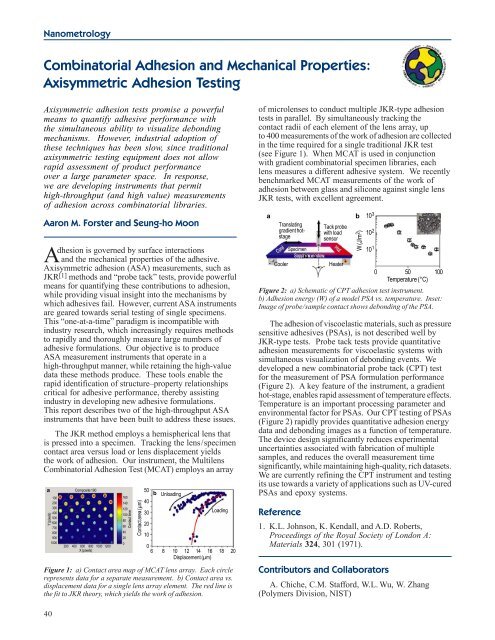Materials Science and Engineering Laboratory FY 2004 ... - NIST
Materials Science and Engineering Laboratory FY 2004 ... - NIST
Materials Science and Engineering Laboratory FY 2004 ... - NIST
Create successful ePaper yourself
Turn your PDF publications into a flip-book with our unique Google optimized e-Paper software.
Nanometrology<br />
Combinatorial Adhesion <strong>and</strong> Mechanical Properties:<br />
Axisymmetric Adhesion Testing<br />
Axisymmetric adhesion tests promise a powerful<br />
means to quantify adhesive performance with<br />
the simultaneous ability to visualize debonding<br />
mechanisms. However, industrial adoption of<br />
these techniques has been slow, since traditional<br />
axisymmetric testing equipment does not allow<br />
rapid assessment of product performance<br />
over a large parameter space. In response,<br />
we are developing instruments that permit<br />
high-throughput (<strong>and</strong> high value) measurements<br />
of adhesion across combinatorial libraries.<br />
Aaron M. Forster <strong>and</strong> Seung-ho Moon<br />
Adhesion is governed by surface interactions<br />
<strong>and</strong> the mechanical properties of the adhesive.<br />
Axisymmetric adhesion (ASA) measurements, such as<br />
JKR [1] methods <strong>and</strong> “probe tack” tests, provide powerful<br />
means for quantifying these contributions to adhesion,<br />
while providing visual insight into the mechanisms by<br />
which adhesives fail. However, current ASA instruments<br />
are geared towards serial testing of single specimens.<br />
This “one-at-a-time” paradigm is incompatible with<br />
industry research, which increasingly requires methods<br />
to rapidly <strong>and</strong> thoroughly measure large numbers of<br />
adhesive formulations. Our objective is to produce<br />
ASA measurement instruments that operate in a<br />
high-throughput manner, while retaining the high-value<br />
data these methods produce. These tools enable the<br />
rapid identification of structure–property relationships<br />
critical for adhesive performance, thereby assisting<br />
industry in developing new adhesive formulations.<br />
This report describes two of the high-throughput ASA<br />
instruments that have been built to address these issues.<br />
The JKR method employs a hemispherical lens that<br />
is pressed into a specimen. Tracking the lens/specimen<br />
contact area versus load or lens displacement yields<br />
the work of adhesion. Our instrument, the Multilens<br />
Combinatorial Adhesion Test (MCAT) employs an array<br />
Figure 1: a) Contact area map of MCAT lens array. Each circle<br />
represents data for a separate measurement. b) Contact area vs.<br />
displacement data for a single lens array element. The red line is<br />
the fit to JKR theory, which yields the work of adhesion.<br />
40<br />
of microlenses to conduct multiple JKR-type adhesion<br />
tests in parallel. By simultaneously tracking the<br />
contact radii of each element of the lens array, up<br />
to 400 measurements of the work of adhesion are collected<br />
in the time required for a single traditional JKR test<br />
(see Figure 1). When MCAT is used in conjunction<br />
with gradient combinatorial specimen libraries, each<br />
lens measures a different adhesive system. We recently<br />
benchmarked MCAT measurements of the work of<br />
adhesion between glass <strong>and</strong> silicone against single lens<br />
JKR tests, with excellent agreement.<br />
Figure 2: a) Schematic of CPT adhesion test instrument.<br />
b) Adhesion energy (W) of a model PSA vs. temperature. Inset:<br />
Image of probe/sample contact shows debonding of the PSA.<br />
The adhesion of viscoelastic materials, such as pressure<br />
sensitive adhesives (PSAs), is not described well by<br />
JKR-type tests. Probe tack tests provide quantitative<br />
adhesion measurements for viscoelastic systems with<br />
simultaneous visualization of debonding events. We<br />
developed a new combinatorial probe tack (CPT) test<br />
for the measurement of PSA formulation performance<br />
(Figure 2). A key feature of the instrument, a gradient<br />
hot-stage, enables rapid assessment of temperature effects.<br />
Temperature is an important processing parameter <strong>and</strong><br />
environmental factor for PSAs. Our CPT testing of PSAs<br />
(Figure 2) rapidly provides quantitative adhesion energy<br />
data <strong>and</strong> debonding images as a function of temperature.<br />
The device design significantly reduces experimental<br />
uncertainties associated with fabrication of multiple<br />
samples, <strong>and</strong> reduces the overall measurement time<br />
significantly, while maintaining high-quality, rich datasets.<br />
We are currently refining the CPT instrument <strong>and</strong> testing<br />
its use towards a variety of applications such as UV-cured<br />
PSAs <strong>and</strong> epoxy systems.<br />
Reference<br />
1. K.L. Johnson, K. Kendall, <strong>and</strong> A.D. Roberts,<br />
Proceedings of the Royal Society of London A:<br />
<strong>Materials</strong> 324, 301 (1971).<br />
Contributors <strong>and</strong> Collaborators<br />
A. Chiche, C.M. Stafford, W.L. Wu, W. Zhang<br />
(Polymers Division, <strong>NIST</strong>)

















